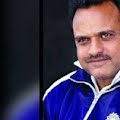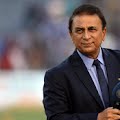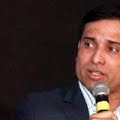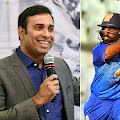By Garfield Robinson
VVS Laxman was named in the Indian Squad for the tests against the touring New Zealanders. He was the one in possession of the number five spot during the last series but with “The Wall” now retired there is the issue of who will bat at three. There are quite a few candidates. Rohit Sharma was in the squad for their last tour and there are also gifted players like Ajinkya Rahane and Cheteshwar Pujara and others waiting in the wings. Coach Duncan Fletcher and the team hierarchy may yet decide to ignore the newcomers (Pujara returns after injury) and entrust that important slot to the very impressive Virat Kohli. Or they could choose to go with VVS.
The Hyderabad batting stylist has occupied that position before and has given good service there, most notably in his 2001 career and series changing Eden Gardens spectacular. But should he now be placed at three? Or should he even be in the squad?
 India’s miracle worker is now 37 and has been showing some signs of decline. His last series was against the team that had always feared him the most, in a land he never failed to conquer; yet his returns were dismal. In five tests down under he scored only 155 runs at 19.57.
India’s miracle worker is now 37 and has been showing some signs of decline. His last series was against the team that had always feared him the most, in a land he never failed to conquer; yet his returns were dismal. In five tests down under he scored only 155 runs at 19.57.
His supporters will no doubt remember the tests against the West Indies at home just prior to the Australian series and point out that he got runs there. Yet cricket followers know that the West Indies’ bowling is not the formidable force of yore and the docile surfaces in India are a far cry from the bouncy tracks found Down Under. Furthermore, the very, very special one struggled when confronted with England’s lively pace attack during India’s visit there shortly before the West Indies series, and could only manage 182 runs at an average of 22.75.
Significantly, Laxman looked nothing like the consummate artist fans were accustomed to seeing. His footwork was hesitant, and while there was still some evidence of his class, he did not seem able to inhabit the lofty heights of efficiency and elegance that only a precious few can manage to combine so effortlessly.
VVS may well dominate the New Zealand attack, but there is the matter of India’s up and coming young players. Should they not be given this opportunity to be blooded at home before being thrown into less friendly foreign conditions?
To be honest, that might not be a strong enough argument. Cricketers nowadays are well traveled and usually get exposed to different conditions from early in their careers. If they are to have long and distinguished careers then the ability to adapt quickly is one quality that would prove very useful. The question that India must ask itself, however, is this: Should they stick with the aging warrior whose skills are obviously waning, or should they turn to a very promising young player eager to make his name? If their main concern is the long-term benefit of the team then the answer should be clear.
Elite sport is a tough business. Sentiment should be shunned in the interest of lasting team viability. And if it seems unfair to focus on one aging superstar and not the other, then the response is that of the two, Sachin Tendulkar is the one who seems most like his real self. And while his days may not now be long he is well equipped to provide guidance to the inexperienced young players that will soon inhabit the middle order.
Laxman needs to resist going the way of many top athletes of the past. History is replete with examples of greats who lingered too long in their sport. Reluctant to accept the first signs of decline they plough on, sometimes becoming more of an embarrassment than an asset to their team and their sport.
In 1981, “The Greatest,” Muhammad Ali, ended his career, or, more accurately, had his career brought to an end by a lumbering Jamaican journeyman, Trevor Berbick. Way past his best by then, Ali was far removed from the smooth, lightening-fast practitioner he was in his prime.It was an end that should not have befallen a man of his stature.
VVS, the foremost batting stylist of his generation, has given much gratification to cricket lovers the world over. None could charm a gathering with artful stroke-play like he could; nor is there anyone who could summon the death-defying knocks that became commonplace for him. That is how fans should remember him; not as a slow-footed, bumbling, batsman who took too long to hang up his helmet.














